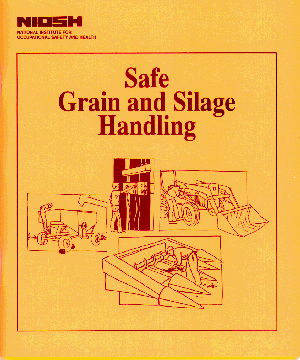Safe Grain and Silage Handling
1995
DHHS (NIOSH) Publication Number 95-109

Public Health Statement
What are the hazards?
For the period 1985 through 1989, the top four leading causes of grain- and silage-handling deaths were:
- suffocation under grain or silage or by gases in bins or silos
- entanglements in augers on all types of machinery
- falls from machinery, bins, and buildings
- electrocutions from machinery contacting an overhead power line
Grain and silage harvesting, transportation, and storage involve machinery, bins, and silos, and a wide variety of work conditions that also result in many other hazards. Experienced farmers know that this type of work can be dangerous. Those who aren't as familiar with farming, or who haven't helped with a certain job, may not be aware of all the risks.
How do these hazards occur?
Farm workers usually do their jobs safely, but injuries can occur when work conditions suddenly change, when one's attention is distracted, or when there are hidden hazards. Examples of hidden hazards are a hillside too steep or too slippery for tractor stability, grain in a silo or bin that looks sturdy but falls away when walked on, hazardous gases that collect above grain or silage, or metal equipment that contacts overhead power lines if raised too high.
How can these hazards be avoided?
Many safe work practices have been developed and accepted by the agriculture industry. This booklet summarizes the work practices that apply to grain- and silage-handling tasks. These work practices range from recommendations for the size of fire extinguishers for combines, to maximum towing weights for tractors, to ways to clear poisonous gas from silos. The booklet's goal is to remind workers of the hazards they are exposed to and suggest practical ways to prevent injuries.
This booklet is organized into five independent sections. Each of the five sections is meant to stand alone. Since some hazards are the same for several different jobs, some information is repeated in more than one section.
How do I get more information?
If you would like extra copies of this booklet, contact the National Institute for Occupational Safety and Health (NIOSH) at the number listed below. If you have questions about safety practices or about obtaining and installing safety equipment, contact your equipment dealer or Cooperative Extension Service safety specialist. For farm-related safety and health information that is not covered in this booklet, contact your Cooperative Extension Service safety specialist or NIOSH.
- Page last reviewed: June 6, 2014
- Page last updated: June 6, 2014
- Content source:


 ShareCompartir
ShareCompartir